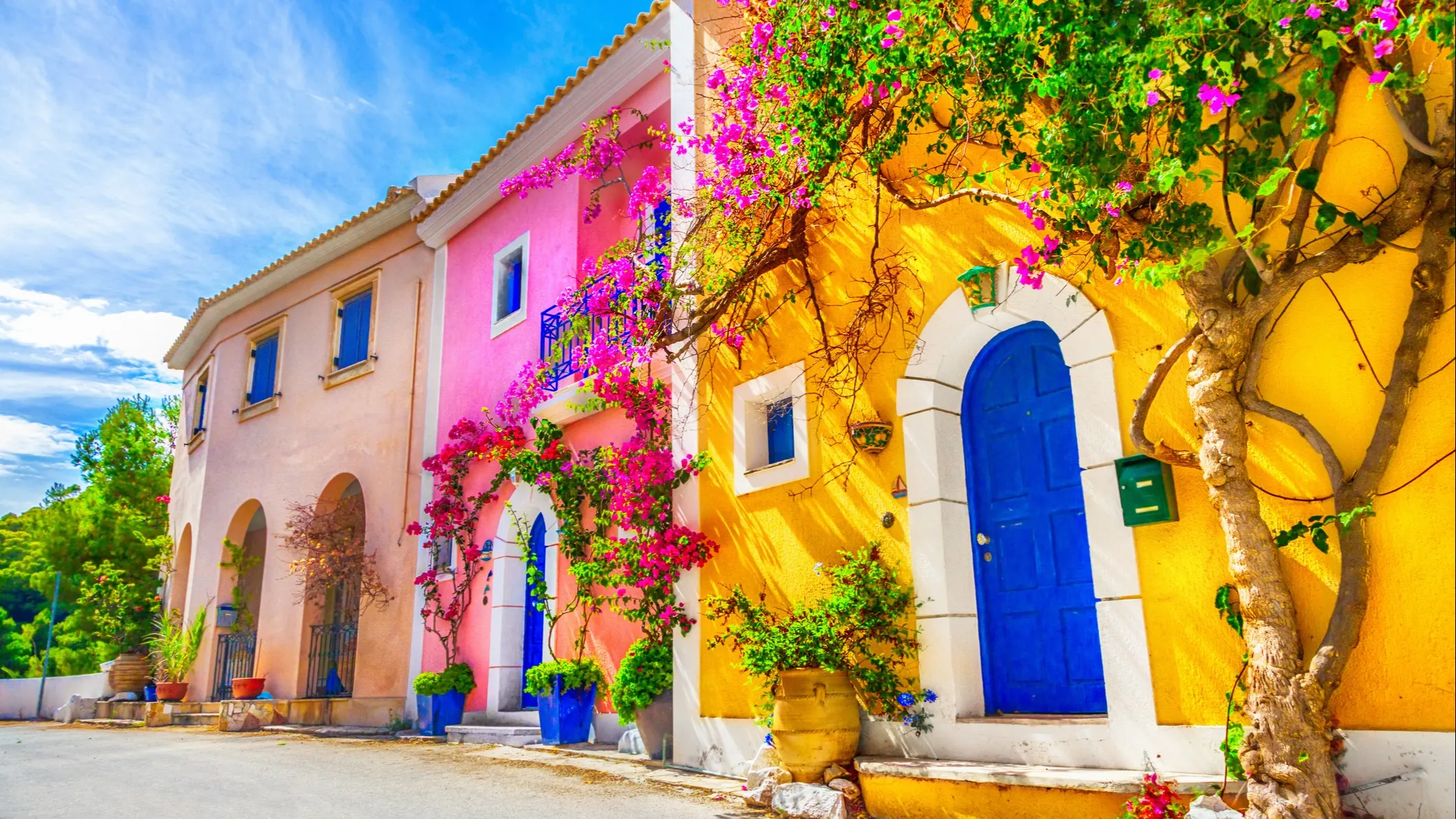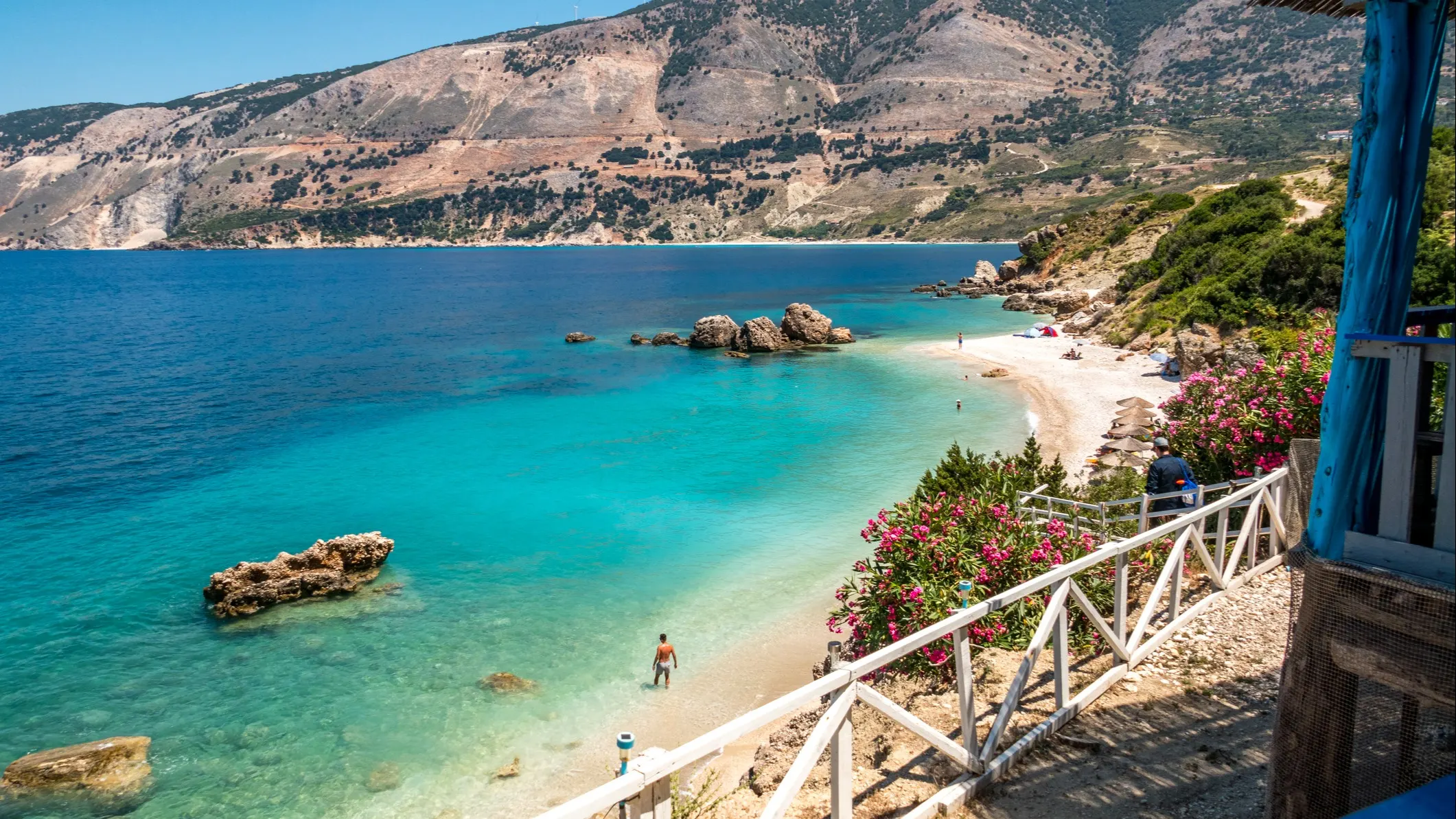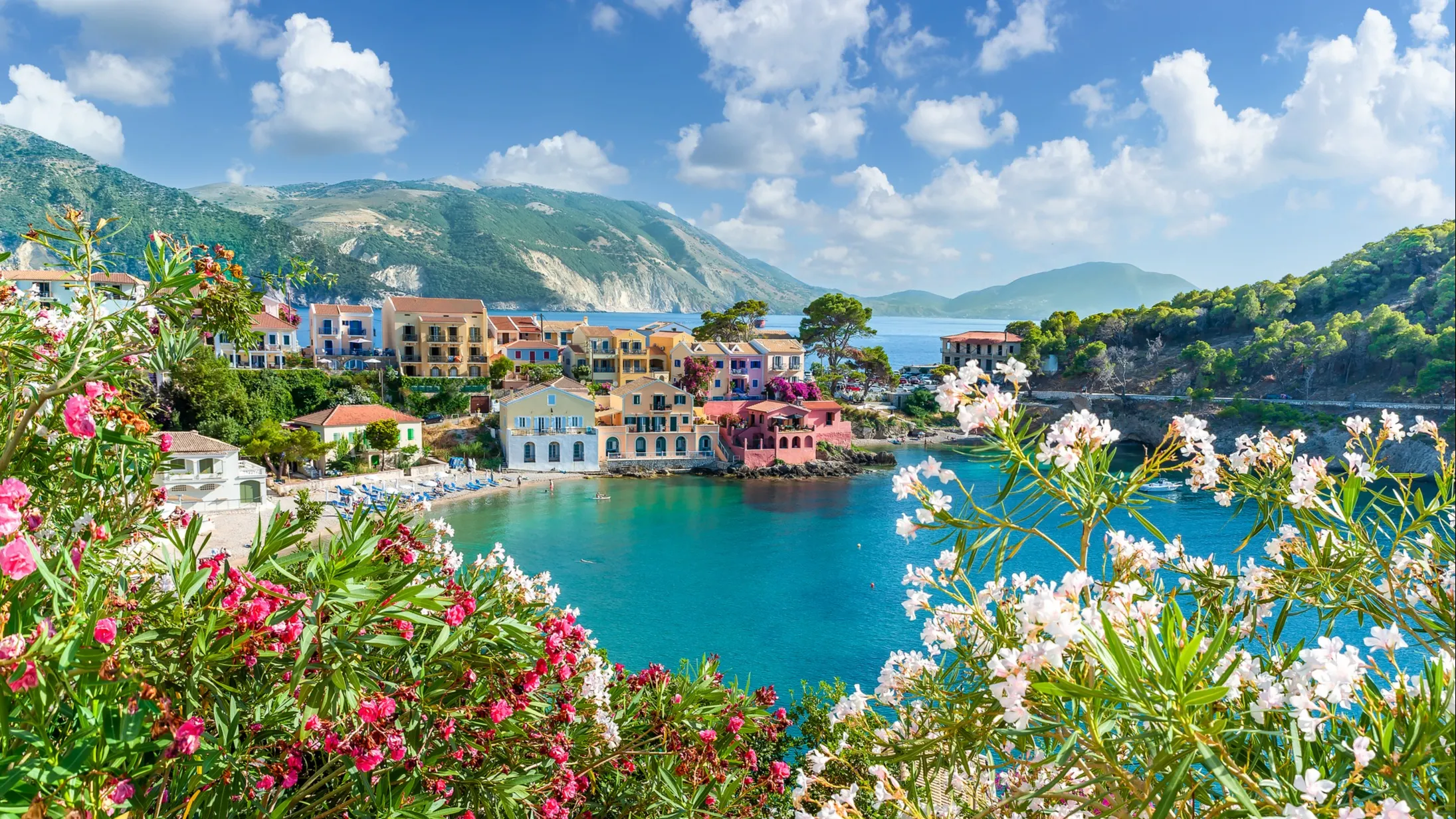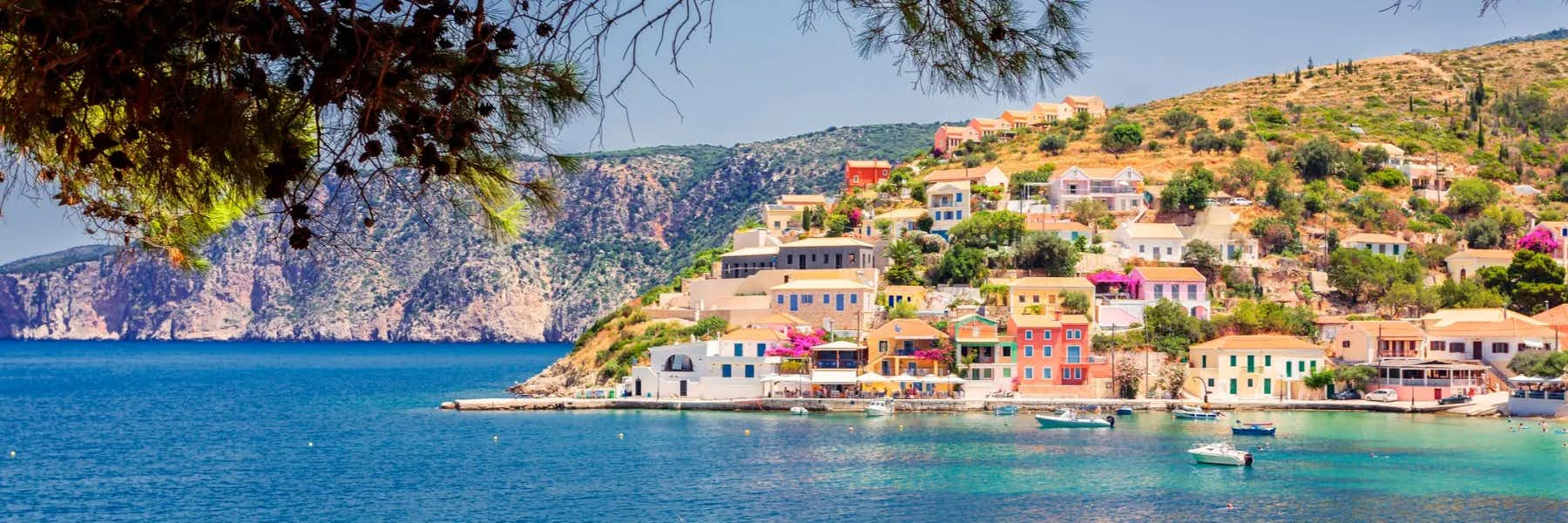When in Greece, do as the Greeks do. And when on holiday in Greece, holiday where the Greeks holiday. But with so many islands to choose from, which do the Greeks prefer? The answer didn’t come easy, but after months of digging, prying, and begging the butchers, bakers, baristas, and bartenders I had slowly befriended while living in Athens, I finally got a whisper of an answer, and to my surprise, they all had the same favorite: Kefalonia.
Being the largest Greek island in the Ionian Sea, and also the birthplace of Odysseus, I was surprised that I had never heard of Kefalonia. I blame Santorini, Mykonos, Crete, Corfu, Paros, Antiparos, Naxos, Lesbos, Kos, Zakynthos, Rhodes, Hydra, Aegina, and the dozen other Instagram favorites for stealing its thunder. But this lack of social media exposure may be Kefalonia’s greatest appeal. Immaculate beaches, authentic Greek villages, mountain hikes, olive groves, and not a cruise ship in sight? Is this for real?

The best way to experience the island is by car, and although there are cheap and direct flights from Athens ($100 round trip; one hour; olympicair.com), any chance to avoid an airport is universally welcomed, so you might as well rent one in Athens ($250 a week; goldcar.es.com) and give yourself an excuse to explore a bit of the Peloponnese on your journey to the ferry. Kyllini, on the western edge of the Attica peninsula, is the main port to the town of Poros in Kefalonia, and it’s a nice three-and-a-half-hour coastal drive west of Athens that takes you over the Corinth canal and through a dozen small Greek beach towns. Ferries leave four times daily ($12 with a car; levanteferries.com), so there’s no need to rush along the picturesque coastline. Instead, stop for lunch in Diakopto at the seaside taverna Kochyli (seashell) for a plate of butter and herb pasta tossed with freshly-caught grilled prawns, and wash it down with half a glass of white wine. Sit a while longer and sip on espresso as the blue horizon beckons you, and then get back in the car and answer the call.
If the thought of driving through the chaos of Athens gives you anxiety, there are hourly buses that depart from downtown Athens to Patras ($25; two-and-a-half hours; ktelattikis.gr) where you can catch another bus to Kyllini and then hop on a ferry to Poros and sort out a car rental after you reach the quiet island ($250 a week; simotascarrental.com), but this will be a long day of travel (more than seven hours) so it would be better to just consider the quick flight to Argostoli and a car rental at the airport.
Finally, if you don’t want to do any driving whatsoever, get to the island by plane or bus, and then use local buses to get you to any towns or beaches you’d like, but keep in mind the schedules are limited and somewhat sporadic (it’s island time after all).
With the necessary travel logistics out of the way, we can start talking about what to do during your (week-long?) stay. If for some reason you have only a few days on the most beautiful of Greek islands, don’t fret, you can still see and do almost everything Kefalonia has to offer, there just won’t be as much leisure time to soak it all in. I’m going to assume you rented a car, because, well, you most certainly should. With the freedom to travel wherever and whenever you want, I recommend starting with a nice long drive around the entire island to get your bearings and to help you decide which beaches you want to spend the rest of your life on. A good route begins in the town of Poros and follows the coast clockwise to Skala, Lourdata, Argostoli, Myrtos Beach, Assos, and finally Fiskardo. I realize it may sound crazy to stick yourself behind the wheel for three hours, especially if you drove all the way from Athens, but I never said you had to stay in the car the whole time.
Every town you drive through has a certain charm that deserves to be seen. Begin at the marina in Poros for fried calamari and a crisp glass of wine and watch the fishermen untangle their nets with a cigarette dangling from their mouths. Stop in Skala and stroll along the beach with gelato while the brilliant Ionian rolls over the sand and stops an inch from your toes. Stock up on fresh fruit, vegetables, and feta at the outdoor market in Argostoli, and if you know what’s good for you, invest in a sun hat, a beach towel, an umbrella, and a gallon of sunscreen while you’re there. Go the extra mile and buy a cheap cooler, a six-pack of beer, and a bag of ice for your beach day at Myrtos tomorrow, because once you lay eyes on that mythical sliver of turquoise water from the viewpoint along the road, you’ll begin separating your life into two parts.

Before I get into the mind-bending beauty of Myrtos, we should get your accommodation settled. Let me say first that there is no wrong place to stay in Kefalonia. The island isn’t enormous, so everything you desire—lounging, tanning, swimming, snorkeling, hiking, biking, shopping, wining, dining—is only a short, scenic drive away. Plus, a studio apartment with a terrace costs about the same ($50 to $100 a night; airbnb.com) in every town. Your home base will only determine what is within walking distance from the wine bucket on your terrace.
Argostoli is by far the largest town (home to the international airport and the longest stone sea bridge in the world) and has the most shopping and dining options, but the beaches aren’t spectacular and you’ll have to drive to any nature hikes you wish to do.
Lixouri is a quick ferry ride from Argostoli and boasts a lively port with an energetic square surrounded by restaurants and tavernas and is also close to the famous red sand and green clay Xi Beach (Grand Blue Beach Residence has villas at Xi Beach if you want the beachy resort experience; $200 a night; but for a more authentic experience, I recommend finding an apartment in Lixouri).
Get Your Free Report on the World's Best Places to Retire:
Get Your Free Report on the World's Best Places to Retire:
Learn more about the best places in the world to retire in our daily postcard e-letter. Simply enter your email address below to sign up for our free daily postcards and we'll also send you a FREE report on The World's Top 10 Retirement Havens.
By submitting your email address, you will receive a free subscription to IL Postcards and special offers from International Living and our affiliates. You can unsubscribe at any time, and we encourage you to read more about our Privacy Policy.

Asos, the unbelievably picturesque town where postcards were invented, is close to Myrtos beach, but accommodation is difficult to find, so better to stay in Makriotika (studio with terrace; $60 a night; airbnb.com), a quiet hamlet in the hills, and just drive to the fairytale Venetian-influenced isthmus every evening for dinner.
Agia Efimia is an easy-to-miss “locals only” gem located on the east side of the island along the narrow channel separating Kefalonia from Ithaki, complete with bougainvillea-strewn sea-view terraces for rent, authentic Greek tavernas, and local markets, and the gorgeous, secret Sikidi beach.
The real jewel, however, tucked into a bay in the crown of Kefalonia, is Fiskardo. Colorful fishing boats and “maybe next life” yachts seemingly hover above crystalline water where sunbeams break only with the darting schools of coddled fish. Cobblestone roads wind you through myrtle-bursting neighborhoods and under cafe umbrellas lining the posh-but-laidback marina. Hike through an aromatic fir forest to a 16th-century Venetian lighthouse, or walk in the opposite direction to a handful of pine-shaded beaches where you can spend the whole day alone, save for a solitary fisherman now and again. Eat oysters on the half-shell, grilled octopus, fresh sardines, and moussaka (Greek lasagna) on a restaurant terrace as the setting sun colors the water a dreamy purple (try Vasso’s restaurant for catch-of-the-day dishes and a great view; appetizers $10; mains $18) and finish the night off with something potent (tsipouro) or sweet (think tortino di cioccolato con gelato) at Elli’s Cafe. Better yet, grab a scoop of gelato to-go and pour yourself a small carafe of ouzo and enjoy them under an orange streetlight while your legs dangle over the side of the stone seawall. Back in your room, use the WiFi to search for a visa extension.

Now to Myrtos beach. There is probably an ephemeral ancient Greek word scrawled in ox blood on a cave wall that captures the feeling Odysseus had when he spotted Myrtos beach after his ten-year journey home from the Trojan War. Was it a sense of joy in being able to see his wife and children after all these years? Or was he more excited to swim again in the single greatest salty cube of blue on Earth? We’ll never know for sure, but one thing is for certain, Myrtos is sublime. The view from the road above stirs a tingle in your spine, daring you to base jump off the cliff, as there’s not a second more to waste. But slow down Evel, you're on holiday. Get back in the car, coast down the windy road to the parking lot, put it in park, turn off the engine, grab your towel, umbrella, cooler, and snacks, find your book and your sunglasses, and don’t forget the sunscreen, because you’re not leaving until the sun disappears into its favorite horizon on the planet. The limestone cliffs of Kefalonia color the sand a white so bright that the water alternates between illusion and reality. After a few steps into the warm water and a dive into the blissful abyss, you question whether life, too, is only an illusion.
After a week of living a life that even the gods' envy, you’ll have to make the journey back to the ferry (or not?). Take your time driving along the east coast of the island, stopping as often as time allows to explore another knee-weakening beach (Biavas, Kapsolimions, etc.) and take a quick dip so you can blame the salty water running down your face on the sea rather than tears. To lift your spirits before boarding the ferry in Poros, make a quick stop at Melissani Cave, a cenote-type of brackish water karst formation. Known in Greek mythology as the Cave of the Nymphs, the geological wonder contains water so clear that a single glance withdraws the same feeling Odysseus felt on his return to the island. The only difference is you will definitely be back before 10 years pass by.
Get Your Free Report on the World's Best Places to Retire:
Get Your Free Report on the World's Best Places to Retire:
Learn more about the best places in the world to retire in our daily postcard e-letter. Simply enter your email address below to sign up for our free daily postcards and we'll also send you a FREE report on The World's Top 10 Retirement Havens.
By submitting your email address, you will receive a free subscription to IL Postcards and special offers from International Living and our affiliates. You can unsubscribe at any time, and we encourage you to read more about our Privacy Policy.
Related Articles
Greece Visa and Residency Information
